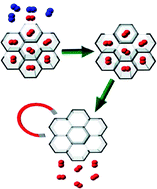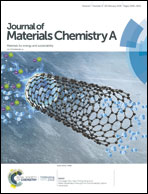Efficient delivery of oxygen via magnetic framework composites†
Abstract
Metal–organic frameworks (MOFs), with their intriguing network structures, large internal surface areas, and tunable pore properties offer the perfect yet largely unexplored alternative for selective adsorption of oxygen. Owing to their thermally insulating nature and often favorable binding of guest species, controlled desorption of the adsorbed molecules from such frameworks can be challenging and energy intensive. To find an energy efficient means for release of these gas molecules, here, we have made use of the heating effect of magnetic nanoparticles to achieve desorption using the Magnetic Induction Swing Adsorption (MISA) process. Magnetic nanoparticles when exposed to a high-frequency magnetic field, heat up instantly; and when present within a MOF, this localized heating is enough to drive the release of adsorbed molecules. Here Co-MOF-74 based Magnetic Framework Composites (MFCs), containing varying concentrations of Fe3O4 nanoparticles, were trialed for triggered oxygen capture. The greatest oxygen adsorption achieved by the prepared cobalt based MFCs was 4.8 mmol g−1 at 1.2 bar, with a Type I adsorption isotherm. For the effective desorption was then triggered by exposure to a magnetic field, with 100% desorption of oxygen accomplished by MFC4, the MOF composite with 12.18 wt% Fe3O4 nanoparticles.



 Please wait while we load your content...
Please wait while we load your content...